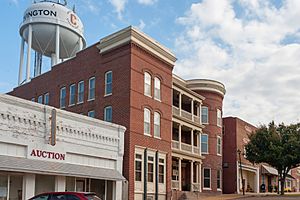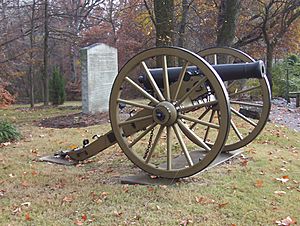Covington, Tennessee facts for kids
Quick facts for kids
Covington, Tennessee
|
|
|---|---|

The Hotel Lindo is one of ten sites in Covington listed on the National Register of Historic Places
|
|
| Nickname(s):
The Heart of Tipton County
|
|

Location of Covington in Tipton County, Tennessee.
|
|
| Country | United States |
| State | Tennessee |
| County | Tipton |
| Named for | Leonard Covington |
| Area | |
| • Total | 11.38 sq mi (29.47 km2) |
| • Land | 11.37 sq mi (29.45 km2) |
| • Water | 0.01 sq mi (0.02 km2) |
| Elevation | 335 ft (102 m) |
| Population
(2020)
|
|
| • Total | 8,663 |
| • Density | 761.85/sq mi (294.15/km2) |
| Time zone | UTC-6 (Central (CST)) |
| • Summer (DST) | UTC-5 (CDT) |
| ZIP code |
38019
|
| Area code(s) | 901 |
| FIPS code | 47-17680 |
| GNIS feature ID | 1281435 |
Covington is a city in central Tipton County, Tennessee, United States. It is the second largest city and the county seat of Tipton County. The city is located in West Tennessee, about 12 kilometers (7.5 miles) east of the Mississippi River.
In 2010, the city's population was 9,038 people. Covington is about 42 miles (68 km) northeast of Memphis. It is part of the larger Memphis, Tennessee Metropolitan Area.
Contents
History of Covington
Early Days and Native Americans
The area where Covington is now located was first home to different groups of Native Americans. They used the nearby Mississippi River as a major trading route. For over 1,000 years, they traded goods across the entire continent. Archeological finds show evidence of this widespread trading.
Tipton County is one of five counties in Tennessee that are next to the Mississippi River. The first Europeans to explore this area were French Canadian explorers Jacques Marquette and Louis Jolliet in 1673. They traveled down the Mississippi River from what is now Wisconsin. It is also thought that explorer de Soto and his men might have passed near here around 1541.
Farms and Plantations
During the 1800s, the Covington area became known for its rich farmland. The warm climate and good rainfall were perfect for growing cotton. Large farms called plantations were set up across the Southern United States. These plantations grew a lot of cotton, which made many landowners very wealthy.
To work on these large farms, many people were forced to come to Western Tennessee. They were made to work without pay as part of a system called slavery. Western Tennessee had many large plantations, and Memphis was a major center for the buying and selling of enslaved people.
Civil War and Growth
During the American Civil War, the Union Army and Union Navy fought to control the Mississippi River. This was important for splitting the Confederate States in two. The Confederate Army tried to stop them. However, the Union Army won battles in Tipton County and other parts of Tennessee. Tennessee was occupied by Union forces starting in 1862.
After the war, in the 1870s, the state government helped build railroads. This made it easier to transport crops to markets. The Memphis and Paducah Railroad reached Covington in July 1873.
Modern Improvements
Many improvements came to Covington over the years. The first telegraph line connecting Memphis and Covington was finished in 1882. In 1894, electric power was brought to the city. A city water system was built in 1898 to give people clean drinking water.
In the 1900s, more changes happened. Streets were paved in 1922. Since 1929, a natural gas company has provided gas for cooking and heating homes and businesses.
With the invention of cars, new roads were built across the country. U.S. Route 51 was one of these important highways. It connects Memphis and places to the south with Chicago. This highway passes through Covington, making it an important stop for travel and trade.
Historic Buildings
The South Main Historic District in Covington has about 50 old houses and business buildings. These structures were built in the late 1800s and early 1900s and are important to the city's history.
Geography of Covington
Covington is located at coordinates 35°33′54″N 89°38′50″W.
The city is part of the Memphis, Tennessee Metropolitan Area. It is about 42 miles (68 km) northeast of the large city of Memphis. U.S. Route 51, a major highway that runs north and south, goes right through Covington.
According to the United States Census Bureau, Covington covers a total area of about 10.3 square miles (26.7 square kilometers). Almost all of this area is land.
Covington is also located near the southeastern edge of the New Madrid Seismic Zone. Geologists believe this area has a high chance of future earthquakes.
Population Information
| Historical population | |||
|---|---|---|---|
| Census | Pop. | %± | |
| 1850 | 368 | — | |
| 1870 | 447 | — | |
| 1880 | 799 | 78.7% | |
| 1890 | 1,067 | 33.5% | |
| 1900 | 2,787 | 161.2% | |
| 1910 | 2,990 | 7.3% | |
| 1920 | 3,410 | 14.0% | |
| 1930 | 3,397 | −0.4% | |
| 1940 | 3,513 | 3.4% | |
| 1950 | 4,379 | 24.7% | |
| 1960 | 5,298 | 21.0% | |
| 1970 | 5,801 | 9.5% | |
| 1980 | 6,065 | 4.6% | |
| 1990 | 7,487 | 23.4% | |
| 2000 | 8,463 | 13.0% | |
| 2010 | 9,038 | 6.8% | |
| 2020 | 8,663 | −4.1% | |
| Sources: | |||
Covington's Population in 2020
| Race | Num. | Perc. |
|---|---|---|
| White (non-Hispanic) | 3,881 | 44.8% |
| Black or African American (non-Hispanic) | 4,242 | 48.97% |
| Native American | 18 | 0.21% |
| Asian | 47 | 0.54% |
| Pacific Islander | 2 | 0.02% |
| Other/Mixed | 322 | 3.72% |
| Hispanic or Latino | 151 | 1.74% |
As of the 2020 United States census, there were 8,663 people living in Covington. There were 3,456 households and 2,179 families in the city.
Arts and Culture in Covington

Tipton County Museum
The Tipton County Museum is located in Covington. This museum shows and explains items from Tipton County's long history. It also has a nature center that teaches about the special plants and animals of West Tennessee.
You can see displays of local animal species there. There are even pieces of mastodon bones, which are from very old animals that once lived in the area. Next to the museum is a 20-acre park with a 0.5-mile (800-meter) walking trail. This park has natural woodlands and a man-made wetland. These areas provide homes for smaller local animals like turtles and birds.
In front of the museum is the Veterans Memorial. This memorial honors soldiers from Tipton County who lost their lives in wars. The museum is closed on Sundays and Mondays. Admission to both the museum and the park is free.
Education in Covington
Covington Public Schools are part of the Tipton County Schools system. The Tipton County School District has several schools:
- six elementary schools
- one K-8 (kindergarten to 8th grade) magnet school
- three middle schools
- three high schools
Schools located right in Covington include:
- Austin Peay Elementary School
- Crestview Elementary School
- Covington Integrated Arts Academy
- Crestview Middle School
- Covington High School
- Tipton County Alternative Learning Center
Dr. John Combs is the Director of Schools for the district.
Notable People from Covington
Many interesting people have come from Covington, Tennessee:
- William F. Bringle – A US Navy Admiral who received the Navy Cross.
- Tony Delk – A professional basketball player and coach.
- Augustus Hill Garland – He was the 11th Governor of Arkansas and later the United States Attorney General. He was also a lawyer and a member of the Democratic Party.
- Isaac Hayes – A famous composer and musician born in Covington. He is in the Songwriter's Hall of Fame. He also voiced the character Chef in the TV show South Park.
- Harvey Hendrick – A former baseball player. He was part of the New York Yankees team that won their first World Series championship in 1923. He passed away in Covington.
- Leigh Snowden – An actress from Covington. Her granddaughter was named Covington in honor of the town.
See also
 In Spanish: Covington (Tennessee) para niños
In Spanish: Covington (Tennessee) para niños

